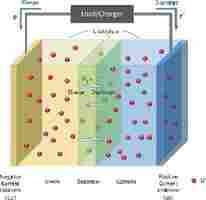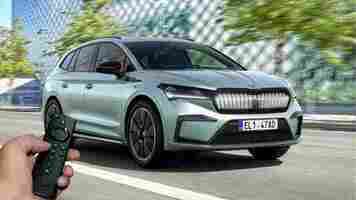Researchers use water to create a safer and more durable EV battery cell
Lithium-ion batteries are the catalyst for our EVs, but they’re not perfect. Specifically, one of their main disadvantages is the flammability of the organic electrolytes currently used for their production.

Thankfully, hope is on the way. A team of researchers from Germany and Japan have developed a solution to fix this problem by replacing organic electrolytes with aqueous (water-based) ones.
At first thought, the use of water sounds like a very straightforward answer to the problem — water is by default inflammable.
But in reality, the integration of aqueous electrolytes into a battery cell has been problematic since 1994, when the idea was first tried out by scientists W. Li and J.R. Dahn .
The main disadvantage of aqueous lithium-ion batteries is their lower energy density compared to their conventional counterparts.
This problem originates from the narrow electrochemical stability window of aqueous electrolytes, so let’s take a moment to explain why this complicated-sounding window is so important.
The electrolyte is the medium that enables the movement of lithium ions between the cathode (positive electrode) and anode (negative electrode) — basically what facilitates the entire electrochemical process needed for the EV battery to work.


Now, we need an electrolyte with a large electrochemical stability window, which means that it won’t get oxidized or reduced during its interaction with the cathode and the anode at the high voltages required for a battery to operate effectively.
The issue with the water-based electrolyte is that it has a really small window when it comes to the interaction with the anode. Because of that, it reacts and produces undesirable hydrogen and oxygen gases.
And although researchers in the past have experimented with different anode materials to avoid this, they weren’t able to significantly expand the electrochemical window and, in turn, increase the battery’s energy density above 100Wh/kg.
As you might have guessed, the researchers managed to develop a new anode material with “impressive performance levels.”
They’ve created a metastable and nanosize molybdenum oxide with a rock-salt structure, which shows a higher energy capacity and a longer lifespan.
Specifically, even when the battery was recharged 2,000 times, its capacity dropped less than 30% — while for conventional lithium-ion batteries the drop is more than 45% after 1,400 lifecycles .
The new material has also managed to increase the battery’s energy density at 107Wh/kg, although that’s still significantly lower compared to current Li-ion batteries at approximately 200Wh/kg .
The research team acknowledges their new tech currently offers lower energy density and voltage , but believe that their study “opens a way to develop high-energy, durable, and safe batteries on the basis of metastable and nanosized oxides with aqueous electrolyte solutions.”
But I, for one, am excited for a less flammable future.
You can read the full study here .
Skoda launches a virtual showroom on Amazon Fire for its first EV
Did you know SHIFT is taking the stage this fall ? Together with an amazing line-up of experts, we will explore the future of mobility during TNW Conference 2021. Secure your ticket now!

Forget about physically going to a showroom, probably somewhere far away, and meeting a bunch of sales people. Skoda is launching a virtual showroom via Amazon‘s Fire TV, The Drum reports.
That way, customers will be able to browse a vehicle’s features and functionalities from the comfort of their couch. The company promises to deliver full 360-degree exterior and interior views, as well as the opportunity to ask questions via text message or email.
In partnership with media agency PHD , the virtual car showroom will house Skoda’s first fully electric vehicle, the ENYAQ iV.
Dubai wants 25% of all journeys in the city to be ‘driverless’ by 2030
This article was originally published by Christopher Carey on Cities Today , the leading news platform on urban mobility and innovation, reaching an international audience of city leaders. For the latest updates follow Cities Today on Twitter , Facebook , LinkedIn , Instagram , and YouTube , or sign up for Cities Today News.

Autonomous vehicle company Cruise will launch its first international robotaxi service in Dubai, with plans to have up to 4,000 vehicles in operation by 2030.
The firm, which is backed by General Motors, will roll out taxi services in 2023, and establish a new Dubai-based company to handle the deployment.
The city wants 25 percent of all trips in Dubai completed via driverless modes of transportation by 2030.
RTA Director General, Mattar Mohammed Al Tayer, said: “Self-driving vehicles contribute to raising the level of traffic safety on the roads, as human error is the main cause of more than 90 percent of accidents.
“It is also distinguished by being environmentally friendly electric vehicles capable of serving a large segment of customers, specifically the category of senior citizens, residents and owners.”
Autonomous testbed
In August 2020, Dubai’s Roads and Transport Authority (RTA) and Dubai Air Navigation Services (DANS) signed a memorandum of understanding (MOU) to exchange expertise on autonomous air vehicles.
This followed legislation introduced in February 2020 to make it easier for driverless vehicles to be tested on the emirate’s roads.
The city is expected to be the launch pad for commercial air taxis, with services projected to begin by 2022. It has carried out advanced tests with autonomous aerial vehicle companies such as Volocopter and EHang.
This is part of Dubai’s plan to reduce pollution and save transportation costs through the use of autonomous vehicles by 2030.
Abu Dhabi trials
In neighboring Abu Dhabi, driverless transport is also being trialed.
Transport chiefs in the emirate have claimed driverless taxis will be introduced this year, with the first phase of the project set to feature three self-driving vehicles providing free transport services from hotels, restaurants, shopping malls and offices at Yas Mall.
Ten more vehicles are expected to hit the roads for the second stage of the initiative, which will extend to locations across the UAE capital.
The service, free of charge in both phases, will be provided from 8am to 8pm.
Although the vehicles are driverless, a safety officer will be present in the driving seat during the pilot scheme to intervene in the event of any issues.
Abu Dhabi’s Integrated Transport Center will be responsible for establishing the necessary infrastructure for the use of self-driving vehicles within the transport network.
In July, the UAE ranked eighth in KPMG’s annual Autonomous Vehicles Readiness Index , performing well in technology infrastructure and the willingness of its people and government to embrace driverless cars.
Do EVs excite your electrons? Do ebikes get your wheels spinning? Do self-driving cars get you all charged up?
Then you need the weekly SHIFT newsletter in your life. Click here to sign up .